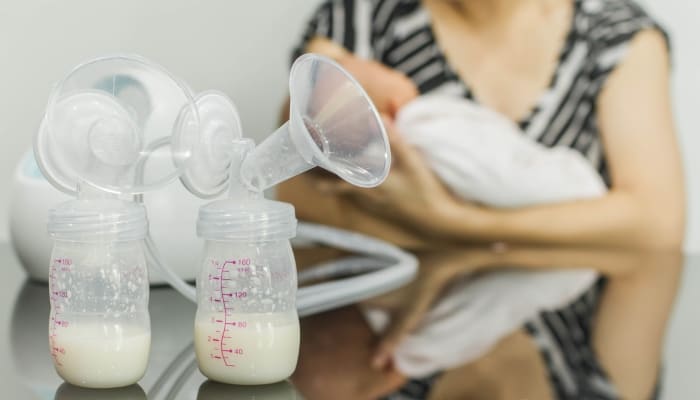Breastfeeding mothers may find themselves in a situation where they need to drop a pumping session. Whether it’s due to a change in their work schedule or their baby’s feeding routine, knowing how to drop a pumping session safely and effectively is essential.
In this article, we’ll explore the reasons why a mother may need to drop a pumping session, the potential risks and complications, and the safe and effective ways to do so.
Understanding Pumping Sessions
Pumping sessions are an important part of a breastfeeding mother’s routine. They allow her to express milk and maintain her milk supply, even when she’s not with her baby. However, pumping sessions can also be time-consuming and may interfere with a mother’s daily activities.
Dropping a pumping session can help a mother save time and reduce stress, while still providing her baby with the milk they need.
Why Drop a Pumping Session?
There are several reasons why a mother may need to drop a pumping session. For example, if she returns to work and finds it difficult to fit pumping sessions into her schedule, she may need to drop a session.
Likewise, if her baby starts sleeping through the night and doesn’t require as many feedings, she may find that she no longer needs to pump as frequently. Whatever the reason, it’s important to know how to safely and effectively drop a pumping session to avoid any potential risks or complications.
Key Takeaways
- Dropping a pumping session can help a mother save time and reduce stress, while still providing her baby with the milk they need.
- A mother may need to drop a pumping session due to changes in her work schedule or her baby’s feeding routine.
- It’s important to know how to safely and effectively drop a pumping session to avoid any potential risks or complications.
Understanding Pumping Sessions
A pumping session refers to the process of using a breast pump to express milk from the breasts. Women who exclusively pump or pump in addition to breastfeeding may have a specific pumping schedule or routine that they follow.

The frequency and duration of pumping sessions can vary depending on the mother’s milk supply and the age of the baby. In general, newborns require more frequent pumping sessions, while older babies may require less frequent sessions.
It is important to establish a consistent pumping routine to maintain milk supply and avoid discomfort or engorgement. This routine may involve pumping at specific times of day or after specific activities, such as feeding the baby.
The length of a pumping session can also vary, but typically lasts between 10-20 minutes per breast. It is important to fully empty the breast during each session to maintain milk supply and prevent clogged ducts.
Overall, understanding pumping sessions and establishing a consistent pumping routine can help maintain milk supply and make the pumping process more efficient and comfortable for the mother.
Why Drop a Pumping Session
Dropping a pumping session can be a difficult decision for breastfeeding mothers. However, there are several reasons why a mother might consider dropping a pumping session:

-
Baby’s needs: As the baby grows and requires less milk, the mother’s milk supply may decrease. Dropping a pumping session can help the mother’s body adjust to the baby’s changing needs.
-
Time constraints: Pumping can be time-consuming, and dropping a session can help free up time for other activities.
-
Weaning: If a mother is planning to wean from breastfeeding or pumping, dropping a pumping session can be a step towards that goal.
-
Comfort: Pumping can be uncomfortable or even painful for some mothers. Dropping a session can help alleviate discomfort and promote a more positive breastfeeding experience.
When deciding whether to drop a pumping session, it is important for mothers to consider their baby’s needs and their own comfort and well-being. It is also important to do so gradually to avoid engorgement or other discomfort.
Mothers should consult with a lactation consultant or healthcare provider for guidance on dropping a pumping session and weaning from pumping altogether.
When to Consider Dropping a Session
Breastfeeding mothers often wonder when they should drop a pumping session. There are various reasons why a mother may consider dropping a session, including a decrease in milk production, a change in work schedule, or simply wanting to reduce the time spent pumping.

If a mother notices a decrease in milk production, it may be time to consider dropping a pumping session. It is important to note that this decrease in production may be due to a number of factors, including stress, illness, or a change in the baby’s feeding routine. However, if this decrease persists, dropping a session may be necessary.
Another reason to consider dropping a session is if a mother’s work schedule changes. For example, if a mother returns to work part-time, she may not need to pump as frequently as she did when she was working full-time.
It is important to note, however, that dropping a session should not be done abruptly. Instead, it is recommended that a mother gradually decrease the number of pumping sessions over a period of time.
Finally, a mother may simply want to reduce the time spent pumping. This may be because she feels that she is spending too much time pumping, or because she wants to spend more time with her baby. In this case, dropping a session may be a good option.
In summary, there are various reasons why a mother may consider dropping a pumping session. These include a decrease in milk production, a change in work schedule, or simply wanting to reduce the time spent pumping. It is important to note that dropping a session should be done gradually and with caution to avoid a sudden decrease in milk production.
Potential Risks and Complications
While dropping a pumping session may seem like a simple process, it’s important to be aware of the potential risks and complications that can arise. Here are a few things to keep in mind:

Clogged Ducts
One potential risk of dropping a pumping session is the development of clogged milk ducts. This occurs when milk builds up in the ducts and is not properly drained.
Symptoms of a clogged duct can include a tender or painful lump, redness, and swelling. To prevent clogged ducts, it’s important to gradually reduce pumping sessions and make sure to fully empty the breasts during each session.
Mastitis
Mastitis is an infection that can occur when bacteria enter the breast tissue through a cracked or sore nipple. Dropping a pumping session can increase the risk of mastitis, as milk can build up in the breast and create a breeding ground for bacteria.
Symptoms of mastitis can include fever, chills, and flu-like symptoms. To reduce the risk of mastitis, it’s important to maintain good breast hygiene and fully empty the breasts during each pumping session.
Engorgement
Another potential complication of dropping a pumping session is engorgement, which occurs when the breasts become overly full and uncomfortable. This can lead to pain, swelling, and difficulty breastfeeding.
To prevent engorgement, it’s important to gradually reduce pumping sessions and make sure to fully empty the breasts during each session.
Prone to Clogged Ducts
Some women may be more prone to clogged ducts than others, and dropping a pumping session can increase this risk.
It’s important to be aware of your individual risk factors and take steps to prevent clogged ducts, such as maintaining good breast hygiene and fully emptying the breasts during each pumping session.
Infections
Finally, dropping a pumping session can increase the risk of infections, such as mastitis or thrush. It’s important to be aware of the signs and symptoms of these infections and seek medical attention if necessary.
To reduce the risk of infections, it’s important to maintain good breast hygiene and fully empty the breasts during each pumping session.
In summary, while dropping a pumping session may seem like a simple process, it’s important to be aware of the potential risks and complications that can arise.
By taking steps to prevent clogged ducts, engorgement, and infections, women can safely reduce their pumping sessions and continue to provide their babies with the nourishment they need.
Safe and Effective Ways to Drop a Session
Dropping a pumping session can be a difficult decision for breastfeeding mothers. However, there are safe and effective ways to do so while maintaining milk supply and transitioning to alternative feeding methods. Here are some tips:

Gradually Decrease Pumping Length and Volume
One way to drop a pumping session is to gradually decrease the length and volume of each session. For example, if a mother typically pumps for 20 minutes and produces 4 ounces of milk, she can gradually decrease the time to 15 minutes and the volume to 3 ounces. This can be done over several days or weeks until the session is eliminated entirely.
Seek Advice from a Lactation Consultant or Healthcare Provider
Mothers who are concerned about their milk supply or experiencing discomfort during the transition can seek advice from a lactation consultant or healthcare provider. They can provide personalized recommendations based on the mother’s individual needs and circumstances.
Use Cabbage Leaves to Relieve Discomfort
Mothers who experience discomfort during the transition can use cabbage leaves to relieve engorgement and reduce inflammation. Simply place chilled cabbage leaves on the breasts for 20 minutes at a time, several times a day.
Gradually Introduce Cow’s Milk or Formula
Mothers who are transitioning to alternative feeding methods can gradually introduce cow’s milk or formula to their baby’s diet. The American Academy of Pediatrics recommends waiting until the baby is at least 12 months old before introducing cow’s milk. Mothers can also introduce a cup or bottle to their baby to help with the transition.
Follow Guidelines from the Centers for Disease Control and Prevention
Mothers who are transitioning to alternative feeding methods should follow guidelines from the Centers for Disease Control and Prevention (CDC) to ensure the safety of their baby. This includes properly preparing and storing formula and using clean and sterilized bottles and equipment.
Monitor Prolactin Levels
Mothers who are concerned about their milk supply can monitor their prolactin levels. Prolactin is the hormone responsible for milk production and can be measured through a blood test. However, it is important to note that prolactin levels may not accurately reflect milk supply.
By following these tips, mothers can safely and effectively drop pumping sessions while maintaining their milk supply and transitioning to alternative feeding methods.
Continuing Your Breastfeeding Journey
Once you have successfully dropped a pumping session, it’s important to continue your breastfeeding journey with confidence and knowledge. Here are some tips to help you along the way:

Nursing on Demand
It’s important to continue nursing on demand, especially during the first few weeks after dropping a pumping session. This will help ensure that your milk supply remains stable and that your baby is getting enough milk. Be sure to offer the breast frequently, even if your baby seems to be satisfied with just one breast.
Stay Hydrated
Staying hydrated is important for maintaining a healthy milk supply. Be sure to drink plenty of water throughout the day, especially during and after nursing sessions.
Take Care of Yourself
Breastfeeding can be physically demanding, so it’s important to take care of yourself. Get plenty of rest, eat a healthy diet, and stay active. This will help you maintain your energy levels and keep your milk supply strong.
Seek Support
Breastfeeding can be challenging at times, so it’s important to seek support when you need it. Reach out to a lactation consultant or breastfeeding support group for help and advice. Remember, you’re not alone in your breastfeeding journey.
By following these tips, you can continue your breastfeeding journey with confidence and knowledge. Remember to stay hydrated, take care of yourself, and seek support when you need it.
Frequently Asked Questions
When can I stop pumping every 3 hours?
The frequency of pumping sessions can be gradually reduced as the baby grows older and starts taking more solid food. Most mothers can reduce the frequency of pumping sessions to every 4-6 hours once the baby reaches 6 months of age. However, it is important to remember that every baby is different and some may still require more frequent pumping sessions.
When can I stop pumping and just breastfeed?
Mothers can stop pumping and exclusively breastfeed once the baby is able to get enough milk from nursing alone. This usually happens around 6 months of age when the baby starts taking solid food and drinking less milk. However, it is important to remember that every baby is different and some may still require pumped milk.
Which pumping session to drop first?
It is recommended to drop the pumping session that yields the least amount of milk or the one that is the most inconvenient. However, it is important to maintain a regular pumping schedule to avoid engorgement or a decrease in milk supply.
How to stop pumping and switch to formula?
Mothers can gradually reduce the frequency of pumping sessions and supplement with formula until the baby is fully weaned. It is important to consult with a healthcare provider to ensure that the baby is getting enough nutrition.
If I miss a pumping session should I pump longer?
Mothers should not pump longer to compensate for a missed pumping session as this can lead to engorgement or a decrease in milk supply. Instead, it is recommended to resume the regular pumping schedule as soon as possible.
How do you safely drop a pumping session?
Mothers can safely drop a pumping session by gradually reducing the frequency of pumping sessions and monitoring their milk supply. It is important to maintain a regular pumping schedule to avoid engorgement or a decrease in milk supply. Mothers should consult with a healthcare provider if they experience any issues with milk supply or engorgement.

Iesha is a loving mother of 2 beautiful children. She’s an active parent who enjoys indoor and outdoor adventures with her family. Her mission is to share practical and realistic parenting advice to help the parenting community becoming stronger.
